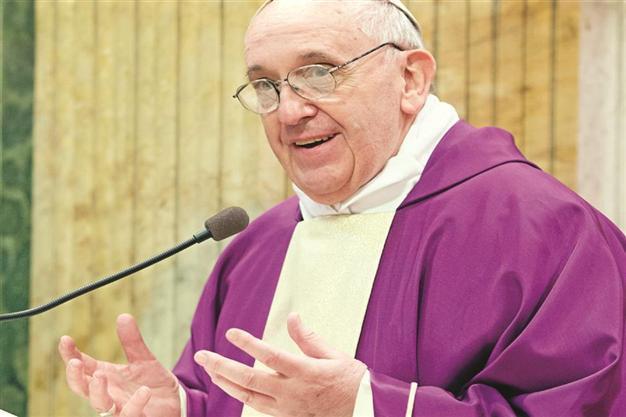Smoke from Vatican kitchen
Aylin Öney TAN - aylin.tan@hdn.com.tr

Pope Francis. AP photo
So the new Pope knows how to cook! That was the great news in the food world last week, as if cooking is an extraordinary act.As the white smoke rose from the Vatican chimney to announce Argentinian Cardinal Jorge Bergoglio as the new Pope of the Catholic Church, no one in the crowd thought that the chimneys of the Vatican kitchen would be piping with smoke in the near future from food actually cooked by the new Pope.
Breaking eggs and flipping omelets like any mortal being is not something that one can easily visualize the elaborately dressed Cardinals doing. The general perception of Vatican dining is a formal table with high-quality food and exceptional wine, served with precious table settings and cutlery; a table not necessarily of extreme extravagance but of utmost high taste, a table of fine dining with gourmet choices, rather than of gourmand indulgence.
Of course the historical recording of the Papal table has not always been that of such elegance. Gluttony, one of the seven sins, has not necessarily escaped Vatican tables. A book written by two social historians, Mariangela Rinaldi and Mariangela Vicini, titled “Buon Appetito, Your Holiness: The Secrets of the Papal Table” reveals a few incidences that have spotted the Vatican tablecloth with signs of the mundane sin of overeating. Reportedly, the thirteenth-century Pope Martin IV was so compulsive in his love for roasted eels steeped in golden wine – Vernaccia of Lazio – that he ate his way to death, quite in a disgraceful way.
Two centuries later, his successor Spanish Pope Alexander VI was known to escape from the Papal table to entertain himself in a tavern close by the Vatican, and obviously not only for enjoying a good morsel of meat, but for even more fleshy pleasures, fathering four children by a waitress of the tavern, Madonna Vannozza. He surely was a Pope of sweet tastes, being the one to first introduce a Nativity Scene entirely built of sugar. A few years later, Leo X elaborated on the Papal sweet indulgence, favoring sugared capons covered in gold leaf. Originally from the famous Medici family always associated with high dining, Leo X was the one to bring stylish extravagance to the Vatican table.
The greedy tables behind the walls of the Vatican are a thing of the past, of course, but there will probably be winds of change in the papal kitchens. Pope Francis is known to be a man of humble nature, so it is not difficult to estimate that the church will head back to basics. Back in Argentina, he is known for cooking his own meals instead of using the chef assigned to him; refused to live in the magnificent mansion of the Church; picked his own phone and gave up his chauffeur-driven car to take the metro or bus.
Pope Francis’s first speech on the first Sunday [March 17] was a call for mercy, “sulle misericordia,” where he emphasized the need to help the poor and fight poverty. His speech was not holy but unpretentious and friendly. One lady among the crowd commented, “Papa della gente!” (Pope of the folks).
So there is new hope with the new Pope! His choice of taking the name Francis after the legendary Francesco d’Assisi, patron saint of animals and nature, is a sign of many hopes. Francesco d’Assisi is known to have refused his father’s wealth and led a modest life celebrating poverty. He believed that nature mirrored God, calling all living creatures brothers and sisters. He is usually depicted with his beloved little birds, “Ucelli.” Hopefully, the new Pope Francis can not only cook but be a hero for ecology like his muse, defend nature and fight climate change. Some criticized Jorge Bergoglio of his role during the dirty war in Argentina. Argentina has a very questionable record also in the agriculture of genetically modified seeds. If the Pope’s empathy for the poor also embraces the farmers and peasants of the world, supporting the right to own their seeds, that will surely be a challenge! His first speech coincided with St. Patrick’s Day, the green day dedicated to nature.
Let’s pray for him and hope his seeds of mercy will embrace the legacy of both St. Patrick and Francesco d’Assisi, and let him be the Patron Saint of Nature!
Recipe of the Week:
Pope Francis told Francesca Ambrogetti and Sergio Rubin, the authors of his 2010 biography, “El Jesuita,” that his favorite film was “Babette’s Feast.” The film, a 1987 Danish drama directed by Gabriel Axel, is on how two pious Christian sisters and their friends are enlightened by a feast cooked by their cook, Babette, a former Parisian cook who spends all the money she won in a lottery on a single dinner. In the film, the isolated Nordic group has a momentary lapse of culinary enlightenment through Babette’s feast, the main course being a bird pie. “Ucelli” pies baked by Babette would be too brutal for the legacy of Francesco d’Assisi, known for his love of birds. Instead, our recipe is a humble “Spaghetti alle povere” (spaghetti of the poor).
Boil 100 g of spaghetti per person in plenty of salted water. Crush one garlic clove and sautee in 3 tablespoons of extra virgin olive oil per person. Add a handful of chopped parsley and, if desired, a bird’s eye chilli pepper; stir until it sizzles and toss the drained spaghetti in the pan. Salt to taste and serve.
Bite of the week
this week. Like Vin Santo & Biscotti, we have an equivalent pairing of sweet wine with biscuits.
Unfortunately, the sublime Vin Santo is not available in Turkey, but one can always enjoy the delightful Madre by Kayra. The wine is not cloyingly sweet, and even better with the crisp spicy kahke of Gaziantep. Our tasting for Kayra included the most delicious “Köylü Kahkesi” (the peasant’s kahke) from the best pastry shop in Gaziantep, Orkide. The wonderfully fragrant peasant’s biscuits are so appropriate to celebrate the Pope of the folks!












